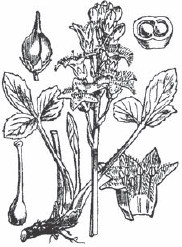MENYANTHACEAE
This is a family of 5 genera of aquatic or subaquatic perennial herbs with free-floating or rooted stems. They are native to tropical, subtropical or temperate regions especially of Asia and were, until recently, included in the Gentianaceae. Leaves are usually alternate, but may be opposite on flowering shoots, and the petioles are sheathed at the base. Flowers may be in bunches, or in racemes or cymes, and are in parts of 5.
Menyanthes trifoliata
Bogbean, buckbean

Family Menyanthaceae
Description
A glabrous perennial herb with a stout rhizome. Petiole may be up to 40 cm long in water but only 5–10 cm long in drier conditions: basal sheaths purplish. Leaves alternate and entire with 3 leaflets, 5–13 × 2.5–9 cm, obovate to elliptic, lateral leaflets somewhat asymmetric; apex rounded or obtuse, base cuneate. Flowers in racemes produced on a leafless scape with pedicels greater than the calyx. Calyx lobed nearly to the base, about 4 mm long, lobes narrow-triangular, obtuse. Corolla 12–14 mm long, white, flushed with pink on the back of the petals which are longer than the tube and reflexed with a fimbriate crest 1–3 mm long. Capsule is ovoid, 2-valved. Flowers from spring to autumn.
Habitat and cultivation
Native to northern temperate Europe, Asia and North America in still, shallow water in marshes and bogs. Grows from seed in spring or root division in spring or autumn, in acid, peaty soil in permanently wet places. Frost resistant but drought tender.
Parts used
The leaves, collected after flowering.
Active constituents1
1) Iridoid glycosides including dihydrofoliamenthin, loganin and menthiafolin2,3
2) Flavonoids including rutin, hyperoside and trifolioside4
3) Coumarins including scopoletin and scoparone
4) Phenolic acids5 including caffeic acid also vanillic and ferulic acids
5) Alkaloids including gentianine and gentialutin
6) Saponins including the triterpenoid menyanthoside
7) Essential oil
Also contains sterols, polysaccharides6 and pectin.
Nutritional constituents
Vitamins: C and carotene
Minerals: Manganese and iodine
Actions
1) Bitter
2) Diuretic
3) Laxative in high doses
Scientific information
Buckbean has been an official medicine in a number of different European pharmacopoeias as a recognised bitter.7
In vitro—It inhibits prostaglandin production8 and its polysaccharides are immunostimulating.6
Medicinal uses
Gastro-intestinal tract
Through its bitter taste:
- anorexia
- dyspepsia
- loss of appetite
Musculoskeletal
- rheumatism
- rheumatoid arthritis
- muscular rheumatism
Pharmacy
| Three times daily | |
| Infusion of dried leaves | – 0.5–2 g |
| Tincture 1:5 (25%) | – 2–6 ml |
| Fluid Extract (25%) | – 0.5–2 ml |
CONTRAINDICATIONS—Diarrhoea, colitis, dysentery.
Precautions and/or safety
Large doses may cause vomiting.7
Historical uses
Internally to treat scurvy; skin diseases; ague. Externally to dissolve glandular swellings. Fresh leaf succus for dropsy and gout.